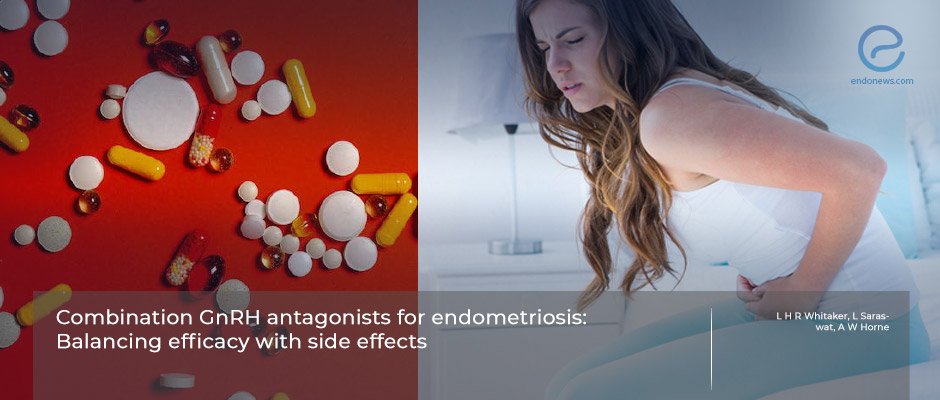Do combination GnRH antagonists improve endometriosis-associated pain?
Jan 2, 2023
Combination GnRH antagonists may provide significant pain relief with minimal side-effect profile.
Key Points
Highlights:
- Women seek treatment options with few side effects as the quality of their life is adversely affected due to endometriosis-associated pain.
Importance:
- Women with endometriosis should be informed about the efficacy and side effects of the medical treatment options used for endometriosis-associated pain.
What’s done here?
- This review was conducted to investigate the place of combination GnRH antagonists for endometriosis-associated pain.
- Endometriosis is associated with a spectrum of pain such as menstrual pain, sexual intercourse pain, urination, and defecation pain.
- Several therapeutic options to manage endometriosis-associated pain include analgesics, drugs that cause ovarian suppression, or surgical removal of endometriosis.
- In this paper, the efficacy and side effects of the GnRH antagonists (relugolix (an oral GnRH antagonist), in combination with 1 mg estradiol and 0.5 mg norethisterone acetate) for the treatment of endometriosis-associated pain.
Key results:
- In endometriosis-associated pain management, step-by-step treatment is applied and the first step consists of expectant management and analgesics.
- The risk of postoperative recurrence is always present.
- Gonadotropin-releasing hormone (GnRH) agonist treatments may be offered as an option in cases that do not respond to analgesics or other hormonal treatments.
- GnRH agonist treatments produce hypoestrogenic status and cause unacceptable side effects such as loss in bone mineral density, and hot flushes.
- GnRH agonists should be used for a short time and with add-back hormone treatments in order to alleviate this side effect profile.
- Combination GnRH antagonists are promising options in endometriosis-associated pain as they cause less frequent and acceptable side effects compared to GnRH agonists.
- After 24 weeks of use of combination GnRH antagonists, no deterioration in bone health and significant improvement in dysmenorrhea, dyspareunia, and non-menstrual pelvic pain were obtained.
- It was determined that all pain scores were improved by using a variety of scales.
- The use of analgesics and the necessity for opioids to manage pain showed significant reduction with combination GnRH antagonists.
Lay Summary
Endometriosis is a chronic inflammatory disease with a broad spectrum of pain symptoms such as dysmenorrhea, dyspareunia, and chronic pelvic pain. It has been understood in light of scientific evidence that endometriosis results in diminished quality of life in these women as these symptoms cause abstinence from school, work, or social interactions. Although there are several treatment options, researchers are in search of an effective treatment modality suitable for long-term use with minimal side effects.
In endometriosis-associated pain management, step-by-step treatment is applied and the first step consists of expectant management and analgesics. In cases unresponsive to these modalities, the next step is hormonal treatment options. Endometriosis surgery is preferred in cases where medical treatment cannot be used, side effects when used, or in cases suspicious of malignancy.
Hormonal treatment alternatives cause many side effects as they cause ovulation suppression and a hypoestrogenic environment. GnRH antagonists combined with add-back hormone treatments have been produced as an alternative to GnRH agonists, especially to protect bone health and prevent loss in bone mineral density.
Whitaker et al., from the United Kingdom, published a paper titled “Combination GnRH antagonists for endometriosis: Balancing efficacy with side effects” in the journal named Cell Reports Medicine.
The authors evaluated the place of combination GnRH antagonists (relugolix 40 mg (an oral GnRH antagonist), in combination with 1 mg estradiol and 0.5 mg norethisterone acetate) for endometriosis-associated pain. After 24 weeks of use of combination GnRH antagonists, no deterioration in bone health and significant improvement in dysmenorrhea, dyspareunia, and non-menstrual pelvic pain were obtained. It was determined that all pain scores were improved by using scales. The use of analgesics and the necessity for opioids to manage pain showed significant reduction with combination GnRH antagonists.
“Although additional safety data is required before combination, relugolix can be recommended as a long-term treatment for endometriosis, these trials present robust evidence for the use of combination relugolix to treat endometriosis-associated pain while mitigating the deleterious side effects of this class of compounds,” they added.
Research Source: https://pubmed.ncbi.nlm.nih.gov/36130483/
endometriosis pain GnRH agonists GnRH antagonists health profile-30 (EHP-30) bone mineral density

